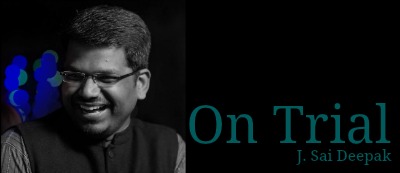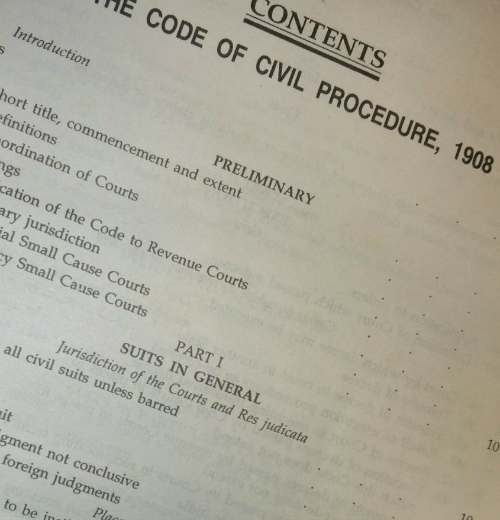
 Framing of issues, as I had observed in my last article here, sets the ball rolling for a conventional trial, that is, the recording of the evidence of both parties. But is a conventional trial mandated in every civil suit? In other words, can a suit be disposed of without parties having to go through this rigmarole? Yes.
Framing of issues, as I had observed in my last article here, sets the ball rolling for a conventional trial, that is, the recording of the evidence of both parties. But is a conventional trial mandated in every civil suit? In other words, can a suit be disposed of without parties having to go through this rigmarole? Yes.
For instance, a suit may be disposed of through rejection of the plaint on the ground that, having regard to the pleadings contained in the plaint, the suit is barred by law under Order 7, Rule 11(d) of the Code of Civil Procedure, 1908 (“CPC”). Order 7, Rule 11 provides six grounds for rejection of a plaint, some of which are factual in nature and some are procedural. Ground (d) is legal. Procedural grounds relate to curable defects and are not necessarily fatal to the suit. Factual grounds are usually treated as issues which require trial and therefore do not result in rejection of the plaint upon filing of an application invoking such grounds. These are framed as preliminary issues for trial and taken up at the stage of final arguments based on evidence led by the parties. A legal ground however, could result in the rejection of the plaint and even the decree of the suit, before trial. For example, if a defendant in a suit for copyright infringement takes the defense that the subject matter in which copyright allegedly vests, is ineligible for copyright protection since it falls outside the definition of “work” under the Indian Copyright Act, 1957, it may be possible for a court to reject the plaint and decree the suit on that ground alone if it concurs with the defendant.
Another provision which may be invoked to obviate the need for trial is Order 12, Rule 6, which empowers a court to pronounce judgment and decree a suit on the basis of admissions of fact made by a party to the suit in a pleading or otherwise, orally or in writing. This would, however, require such admission to be unequivocal, unambiguous, and material to the claim of the plaintiff or defense of the defendant, as the case may be. If there is scope for more than one plausible interpretation of the fact or further evidence needs to be led in relation to that fact, a court may deem it fit to allow the suit to proceed to trial on the ground that a clear-cut case of admission as required under Order 12, Rule 6 has not been made out by the applicant.
A suit may also be decreed in terms of a settlement arrived at by the parties under Order 23, Rule 3. While a judgement delivered under Order 7, Rule 11 or Order 12, Rule 6 is appealable, a consent decree is not unless the terms were arrived at by fraud or misrepresentation.
Summary judgment under Order XIIIA of the CPC
The CPC as amended by the Commercial Courts Act, 2015, has provided yet another way to decree a suit of a commercial nature without it having to go through the motions of a conventional trial. Order XIIIA of the amended CPC, which I have discussed once earlier in the series, provides a mechanism under which a summary judgement may be delivered in commercial suits if the conditions set out in the provision are satisfied. In a recent judgment of a division bench of the Delhi High Court, I had the privilege of assisting the Court in examining the stage at which Order XIIIA may be invoked, the manner of its invocation and application. I was instructed in this matter by the NCR-based law firm, Sim & San.
The judgement, which I would strongly recommend law students to read, discusses the institution of a suit in great detail with analysis that spans several provisions of the CPC. One of the questions before the Court, perhaps for the first time, was whether it is open for a court to invoke Order XIIIA suo moto in a commercial suit to dismiss it even before issuing summons to the defendant.
In addressing the issue, the Court undertook a detailed examination of the scheme of Order XIIIA, including its placement in the CPC after issuance of summons to the defendant under Order V and before framing of issues in Order XIV. A clear reading of the procedure laid out reveals the following:
- An application under Order XIIIA is contemplated to set the ball rolling.
- The application may be made at any time after summons has been served on the defendant, but not after issues have been framed in the suit.
- The application may be moved by either the plaintiff or the defendant.
- What the application must specifically contain has been prescribed in Rule 4 of Order XIIIA.
- The respondent to the application must be given a period of 30 days to respond to it.
- Apart from the evidence already on record, both parties may lead additional evidence to support their respective contentions.
- A date of hearing in the application must be fixed, of which the respondent to the application must be informed.
- The necessary grounds on which a summary judgement may be delivered by a court are – (a) that the respondent to the application (either the plaintiff or the defendant) has no real prospect of succeeding in the suit and (b) there is no compelling reason why the suit should not be disposed of before recording of oral evidence.
- Rules 6, 7, and 8 set out the various orders that a court may pass in deciding such an application.
Nowhere does Order XIIIA permit a court to invoke and apply this framework suo moto, much less dismiss the suit even before the defendant enters appearance. Apart from the fact that Order XIIIA does not empower a court to do so, such power, if it had been vested, would have been at loggerheads with the adversarial legal system followed by Indian courts. Extracted below are the relevant observations of the Division Bench in this regard:
“23. From the provisions laid out in Order XIIIA, it is evident that the proceedings before Court are adversarial in nature and not inquisitorial. It follows, therefore, that summary judgment under Order XIIIA cannot be rendered in the absence of an adversary and merely upon the inquisition by the Court. The Court is never an adversary in a dispute between parties. Unfortunately, the learned Single Judge has not considered the provisions of Order XIIIA CPC in this light. 24. In view of the discussion above, since no summons had been issued and obviously no application had been filed by the respondents for a summary judgment, the learned Single Judge could not have dismissed the suit invoking the provisions of Order XIIIA CPC.
- In view of the discussion above, since no summons had been issued and obviously no application had been filed by the respondents for a summary judgment, the learned Single Judge could not have dismissed the suit invoking the provisions of Order XIIIA CPC.”
To me, the court’s recognition and reinforcement of the adversarial nature of the Indian legal system, notwithstanding the amendments made to the discovery mechanisms in the CPC in 2002 and through the Commercial Courts Act, 2015, is one of the highlights of the decision. In the near future, we can expect a few more decisions that revolve around provisions introduced through the Commercial Courts Act.
In the next part, I will proceed with a discussion on commencement of and preparation for trial.
Sai Deepak is an engineer-turned-law firm partner-turned-arguing counsel. Sai is the founder of Law Chambers of J. Sai Deepak and appears primarily before the High Court of Delhi and the Supreme Court of India. He is @jsaideepak on Twitter and is the founder of the blawg “The Demanding Mistress” where he writes on economic laws, litigation, and policy. All opinions expressed here are academic and personal.

